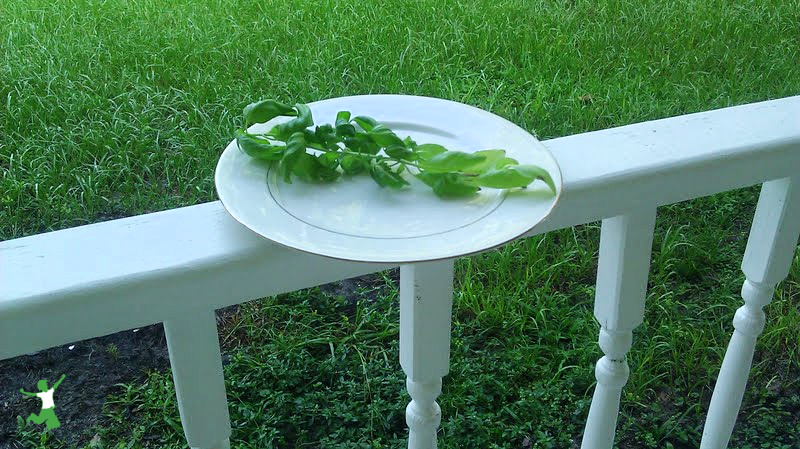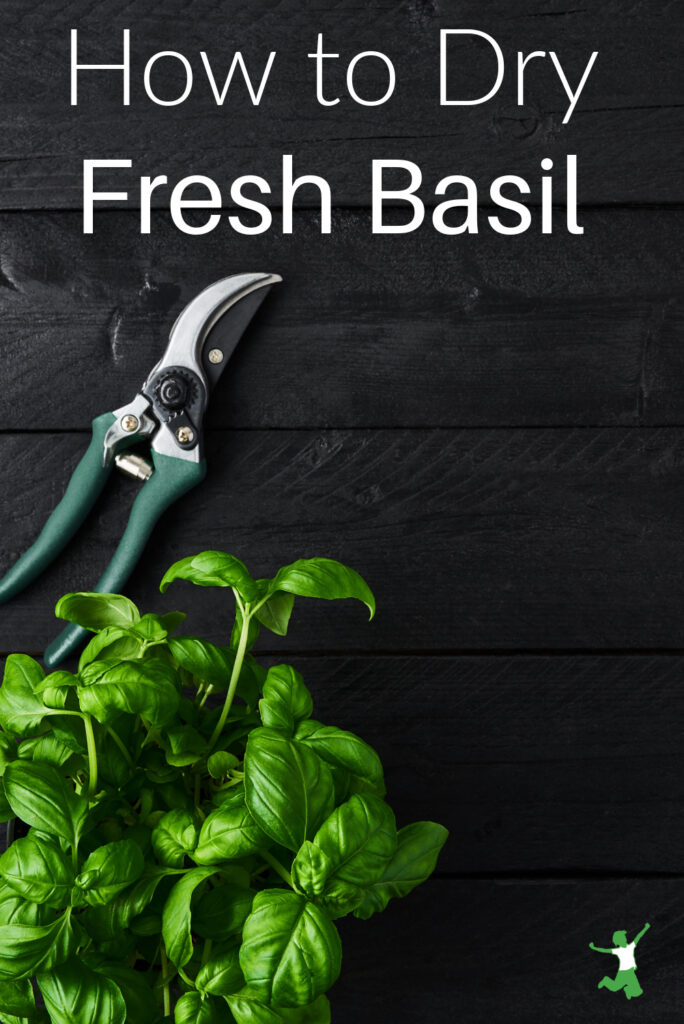Table of Contents[Hide][Show]
How to dry fresh basil from your garden or purchased at the store to preserve nutrients and flavor for all your cooking needs.

I had a large amount of fresh basil from my herbal garden window this season, so I thought I would share how I dried the fresh sprigs I didn’t use right away to preserve them for later use.
Like many herbs, basil is originally native to India.
It is probably best known, though, as a culinary herb used pervasively throughout Italian cuisine.
Let me just tell you that using your own fresh and dried basil and others such as freshly dried oregano really makes the flavor pop!
Here are just a few of the dishes where I use it.
- Easy pizza sauce recipe
- Homemade red sauce recipe
- Coconut flour pizza crust
- Sprouted flour pizza crust
- Almond flour pizza crust
- Breakfast pizza recipe
- Gluten free pizza crust recipe
Homemade Dried Basil
I decided to make dried basil so that I would have it available all year until I grow it again next season.
It was a bit intimidating at first as I had never dried herbs before.
As it turns out, it is quite easy to do!
This process is important to know for those who buy fresh herbs from the store too.
Instead of tossing the sprigs that you don’t use, why not dry them instead?
5 Steps to Dry Fresh Basil
Follow these easy steps and your fresh basil sprigs will be ready for drying in less than 10 minutes.
- Snip the basil sprigs off the main plant before it flowers. No worries if yours is already flowering, just be aware that your basil may not be quite as full flavored.
- Remove all the leaves from the stems. I like to do this by hand rather than by cutting. Discard or compost the stems.
- Chop the basil leaves into small pieces. Take care not to chop too small. I do not rinse my basil leaves as I want to preserve any natural lactobacilli and beneficial yeasts on the leaves.
- Place the basil pieces on a white, nonbleached cotton towel. Flour sack cloths or tea towels work great.
- Put the towel in a place where it won’t be disturbed for a few days away from heat and light but with plenty of air circulation.
Process and Store
Once the basil is dry after a few days, you will notice that it retains its beautiful green color.
It doesn’t turn brown like it would if you tied up the basil in bunches and hung it upside down.
Place the dried basil pieces in a food processor and pulse a few times to chop into very small pieces if desired.
Store dried basil in an airtight container in a cupboard.
Glass will retain the flavor the best. This article on how to properly store bulk herbs gives other tips on how to best preserve potency.
Dried basil and other home-dried herbs are best used within a year.
How easy is that? Do you have special tips for drying basil or other herbs?









i just dried my basil a couple days ago. i pulled the leaves from them stems and got distracted by the kids and forgot about it until morning. when i went back in the garage to see if the basil was ruined in the morning, it was already mostly dried. i just mixed up the pail and set it out in the sun. it was completely dried out by the afternoon.
if i would have known it was so easy, i would have planted more herbs!
i didn’t know about the flowers. thanks!
I lately found an even easier method to deal with the large amounts of basil I sometimes get from my CSA.
I just wash and dry it, pick off whole leaves, and add it too the big jar of basil I keep in the freezer. I then use and chop or not as needed.
I was really surprised that it tastes just like fresh.
I don’t wash my basil as I want to preserve any natural lactobacilli and beneficial yeasts on the leaves. It’s organically raised so this is fine.
Love the freezer idea!
If I were harvesting from a container, especially grown inside, I would do this as well. With herbs grown in the ground, I just can’t bring myself to do it. I don’t want to eat bugs or insect eggs, and we use horse manure in our garden.
Why didn’t I think of a big jar. I’ve kept a baggie in the freezer and added to it but a jar would be so much better. Love freezing it fresh. When I use it in recipes it tastes like I just picked it. Thanks for the tip!
Great post Sarah. I’ve been getting so much fresh basil fron my CSA farmer lately that I also decided to dry it. I use dehydrator. It works perfectly. After the basil is dry I like to grind it and add to different sauces and soups. It works wonders. Sarah, do you have any recipes for zuccini? I’ve been flooded with tons of zuccini lately and the only thing I can think of is pancakes and soups.
What’s the purpose of the towel being white? I’m asking this because I don’t have one. Can it be any piece of white cotton…like a sheet?
The dyes used in cotton manufacturing are toxic (unless you purchase an organic, nontoxic, sustainable towels in which case the dyes are natural) and you don’t want anything you eat exposed to these chemicals. This is why underwear should be white as well but that is a different subject entirely! 🙂
That reminds me of an article I just read a few days ago that said women who wear less clothes live longer on average. One of the theories was that they aren’t exposed to as much toxic detergents but I wonder if fabric dyes play in to that too. Neat!
perfect timing! I just got a bunch of basil with our CSA
I like to mix it with some olive oil in the food processor and freeze it in cubes in an ice cube tray lined with cupcake liners. When they are frozen, I put them into a zip bag and store them in the freezer. I like the flavor much better than dried.
I love herb gardening and harvesting the herbs when Fall arrives. For a high moisture herb like basil its best to put it in your oven and set the temperature low to preserve nutrients and flavor. Herbs that are easy to dry by leaving them sitting out in the sun are oregano, sage, rosemary, and mint. So far I’ve dried all those successfully and stored them in old glass spice jars.
I use my herbs on top of pizza, in salads, or in the wonderfully good herb and chicken broth soup. Really nothing is better than plain herb soup. Simply take 2 tsp each of your favorite herbs and simmer them right in.
Dried Homegrown Basil for Sensational Pizza – The Healthy Home Economist http://t.co/KbYhWYF
Dried Homegrown Basil for Sensational Pizza – The Healthy Home Economist http://t.co/DAMdzHt
I like to lay my herbs out on a baking sheet (whole leaves) and dry them in the oven at 180*F — then, when dried, I ‘crumple’ them with my hands and store them in air tight containers until I am ready to use them!
Thus far, this season, I have dried, Peppermint, Rosemary, Sage & Oregano.
Doesn’t heating them at such a high temperature cause a loss in flavor and/or potency? Have you tried dehydrating at a lower temp by chance?
I haven’t had any problems with a loss in flavor or potency, but I usually keep the door on the oven cracked as well, which probably helps. Sorry, I should have mentioned that in the first place. They also usually only take an hour or so to dry this way.
I prefer it because at my house (we live on a farm) I don’t feel we have an appropriate area where I could hang dry them w/o dust etc catching on the herbs :/